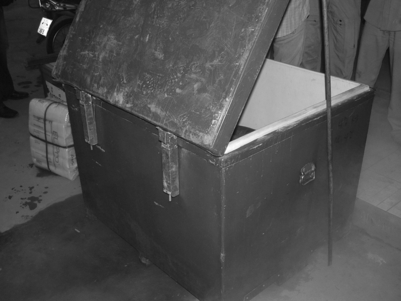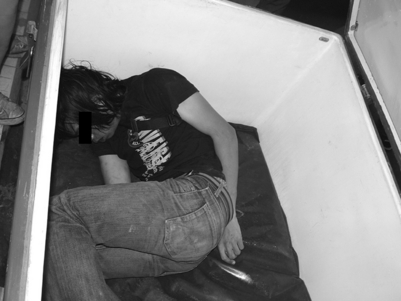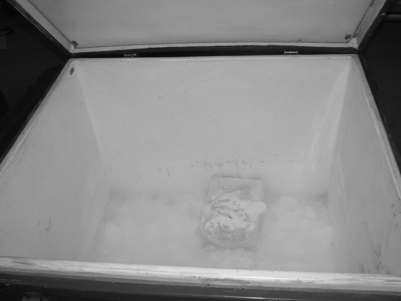A Carbon Dioxide Fatality from Dry Ice
Abstract
Abstract: This report documents a rare case of carbon dioxide intoxication in a young healthy male. The deceased hid in a small plastic container, size 1.5 × 1 × 1 m, and within 5 min he was located suffering convulsions and was reported as dead within minutes. Scene investigation revealed dry ice in the container. Autopsy findings were unremarkable. The probable cause of the convulsions was carbon dioxide intoxication due to both the dry ice sublimation and the small confined space in which he was hiding. This report emphasizes the significance of scene investigation in establishing the cause of the death.
Carbon dioxide (CO2) is a colorless, odorless, non-irritating gas that may cause asphyxia by replacing oxygen (1,2). Its molecular weight is 44, which means that it is heavier than air and easily settles when it accumulates in the absence of turbulence. Thus, manholes, wells, silos, tanks, ship cargos, and cellars may contain excess amount of CO2 (1,3–6). There are reported cases that in nonventilated places consciousness is lost in seconds and death follows rapidly (3–6). CO2 may also cause asphyxia when it accumulates in a small closed space, as a result of oxygen depletion (1). Examples of confined spaces are refrigerators, suitcases, washing machines, closets, etc. (1,7,8). The term “confined space hypoxic syndrome” has been used to describe these circumstances (4,6) and there have been reports of deaths in such cases (1,3–9).
In this report, we describe a death resulting from confined space hypoxic syndrome due to the deceased hiding in a small closed space containing dry ice.
Case Report
A healthy 20-year-old male was fleeing a confrontation in a dry ice factory and hid in a plastic container, 1.5 × 1 × 1 m in size. This type of container is normally used to store ice and food in Thailand (Fig. 1). Within ∼5 min, the factory security guard and a worker opened the container after they observed the container move. The deceased was observed convulsing for ∼1 min before he stopped. EMTs were called; however, he was declared dead when they arrived (Fig. 2). Scene investigation revealed that the young man lay on the mattress over the dry ice inside the container (Fig. 3). The container could be opened from inside and there was no warning sign that it contained dry ice.

—The container.

—The body in the container.

—Some dry ice in the container.
At autopsy, the deceased had no gross or microscopic evidence of disease or injury. External examination of the body was unremarkable. The lungs showed moderate congestion. The brain showed mild edema and congestion. The gastric mucosa and the pancreas were within normal limits. The results of all toxicological tests including alcohol, commonly abused drugs, and psychiatric prescription medications were negative.
Discussion
Asphyxia, particularly CO2 intoxication, is a diagnosis based on the scene investigation and circumstances surrounding a death with the exclusion of other causes of death (1). There are no pathognomic autopsy findings and blood analysis for CO2 content has no diagnostic significance, as CO2 rapidly accumulates after death (1). In this reported case, the scene investigation was the most important step.
Dry ice undergoes sublimation to CO2, direct conversion from a solid into a gas bypassing the liquid state. If it is warmed rapidly, large amounts of CO2 are generated. Previous case reports have described illness and death caused by occupational exposures (10,11) and unintentional exposures during use or transporting of dry ice (12–15). Hypoxia can occur from exposure in a small confined space as in this case shortening the duration of asphyxia.
There was no evidence of hypothermia and/or burning from the dry ice due to protection by the mattress inside the container. Therefore, the possible cause of death in this report was carbon dioxide intoxication caused by both the small confined space and dry ice sublimation.
The other interesting observation in this case was the symptoms exhibited by the deceased prior to death. Carbon dioxide, at low concentration, has little, if any, toxicological effects. At higher concentrations, it can cause increased respiration, tachycardia, cardiac arrhythmia, and unconsciousness (2). Concentrations higher than 10% may cause convulsions, coma, and death (2). These symptoms were observed in this case.
Conclusion
This case report is an unusual one of carbon dioxide intoxication caused by exposure to dry ice in a small confined space. Death occurred rapidly after the exposure. For general safety, a warning label should be on dry ice containers.




